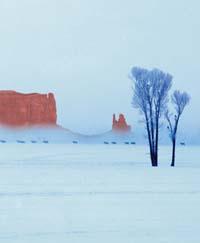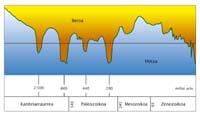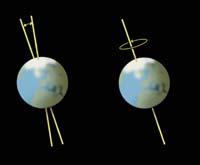The desert hidden in ice cycles

The Earth cools down and warms, the entire planet. It does so in cycles; some years the average temperature is low and polar ice colonizes many zones. In other years, the opposite occurs, the average temperature is higher and the ice goes back to the poles. These incidents can be considered by both geologists and biologists.
From the geological point of view, it is important that the ice advance and back. The time when there is much ice is called glaciation, while the interglacial period is called interglacial. The name itself is representative in terms of the classification of times: ice is the reference point. But as for deserts, we must take into account the interglacial epochs.
From a biological point of view, this ice dance affects ecosystems. For example, in southern Spain, in Granada, mammoth remains have been found, indicating that during the last glaciation the ice reached a very high south. It may not reach Granada, but there it would make it so cold as to be able to live furry animals. That is, the ice shifted to the south the appropriate ecosystem for mammoths.
But the opposite occurred also in interglacial times. The time of the dinosaurs is a good example: despite being animals of warm weather, their fossils have been found near the pole, for example in England and Canada. The dinosaurs appeared and developed in an interglacial era that, when they disappeared, still lasted. It can be interpreted in reverse: finding dinosaur fossils is a trace of a warm climate.
5 colds
In the climate cooling and warming cycle, ecosystems change a lot. For example, Scandinavia, Scotland and Canada are covered by an ice layer of three kilometers thick during the glaciations. There it is impossible to live and very difficult in England, northern central Europe and half of the United States. And vice versa, in the lands located in the South Pole there were forests 250 million years ago. There they have found fossils of trees and leaves. These fossils are, without a doubt, a record of temperature cycles.

In the long term, during the temperature cycle there have been five cold periods, that is, five of glaciations. The first occurred 2,500 million years ago and today we are in the last; from the general point of view, we are within a glaciation. (From this point of view, it is clear that deserts exist in the age of glaciations). And they have also been especially hot times in the history of climate, like dinosaurs.
In the short term, climatologists have identified eight climatic cycles over the past 740,000 years, four glaciations over the past 400,000 years.
The traces of the last glaciations are more marked than the old ones, so the temperature profile is more defined for the climate of the last millennium than for millions of years. However, scientists have obtained sufficient data to observe the general trend. These data are clear
Temperature cycles cannot be predicted, since they are not regular. Sometimes it takes little in a period of cold or heat and sometimes much, it is not possible to determine the timing of the cycle.
Milankovitx
This cycle is irregular because it depends on many factors. It is generally assumed as a consequence of the movement of the planet. Precisely an astronomer proposed this idea: The Serbs Milutin Milankovitx.

According to Milankovich, three factors influence the cycle of temperature: the inclination of the axis of the Earth, the shape of the orbit around the Sun and the precession, which somehow indicates where the axis is inclined.
The modification of the axis of the Earth is the factor that most influences the three. The shaft needs 41,000 years to complete a cycle, which moves in scales between a minimum inclination of 21.5 and a maximum of 24.5. In these circumstances, the more inclined it is, the stronger the temperature on Earth. It has a great influence on the climate.
It also influences the orbit around the Sun. Within a cycle it changes, stretches a little and shortens. They are small changes, since the orbit is very round even at the highest deformation, but it is a variation that can influence the seasons of the year.
We must also take into account the precesion, it is not the same as the axis of the planet is tilted from one side to the other. According to the inclination, in one hemisphere the summer will be and in the other the winter; the precesion changes. But it's not just that; as the orbit is not totally circular, the Earth and the Sun approach and move away on each tour. Finally, the influence of the precession is that summer occurs in one or another hemisphere at the closest point to the orbit. And the two hemispheres are not equal, so in both cases the Earth is not heated in the same way.
Milankovitxe analyzed these three factors. The three vary with time, each with its natural frequency, and the three act in one way or another. But they are not the only ones, but other factors such as continental distribution, solar activity, etc. Consequently, the climate cycle is very complex and irregular.
Ancient deserts

If the climate cycle is irregular, the expansion of deserts is even more irregular, since not only the climate but other factors influence. That is why it is difficult to predict the future of deserts. But looking at the past can help to understand the natural evolution of dry areas; it is possible to investigate remains of ancient deserts.
There are several ways to search for ancient deserts. On the one hand, the fossils indicate whether or not an area has been a desert. For this purpose, fossils of animals, plants and pollen have been used. A good example of this last is the land dried in Namibia 2,2 million years ago, in which it has been possible to verify the appearance of the desert as the sea receded. On the other hand, the areas where dust accumulates are also a sign of ancient deserts and, in some cases, the geological footprint left by an old desert is visible from the satellites.
These data help to understand how nature itself has extended in some cases deserts and to some extent the climate of the past. However, they do not give the prediction of the evolution of today's deserts, that is, they do not determine to what extent nature and human being are responsible for the expansion of deserts.





